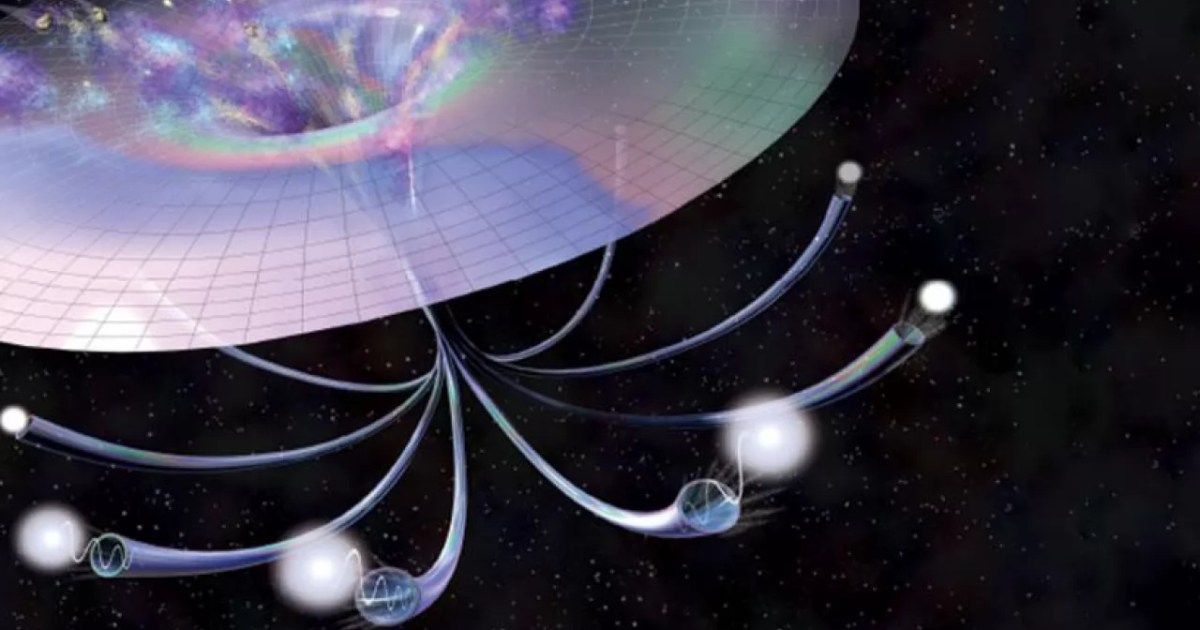Sign up for the Starts With a Bang newsletter
Travel the universe with Dr. Ethan Siegel as he answers the biggest questions of all.
In the 1920s, we first measured the distances to objects beyond our own Milky Way, and swiftly discovered that the Universe was expanding: consistent with how Einstein’s General Relativity tells us the Universe would evolve. If the Universe was expanding today, that implies it was smaller — and hotter, and denser, and more uniform — in the past, leading to the idea of the hot Big Bang. Starting in the 1960s, the Big Bang’s greatest predictions were confirmed, leading to widespread acceptance of the theory. However, a few unexplained puzzles remained, leading scientists to question whether the most extreme predictions of the Big Bang, including arbitrarily high temperatures and an origin from a singularity, were actually correct.
In the early 1980s, a revolutionary new theory was proposed, intending to solve those puzzles: cosmic inflation. Theorists rushed to work on inflation, figuring out which “flavors” of inflation successfully led to a hot Big Bang and then making a series of predictions that could be compared and tested against the differing predictions of the Big Bang without inflation. Over the 80s, 90s, and 00s, those predictions were tested and confirmed, with inflation passing every observational test thus far.
However, inflation still has its critics, and its major criticisms fall into two categories:
the measure problem, which concerns the difficulty of quantifying the likelihood of inflation describing our Universe,
and the fact that “inflation could have predicted literally anything,” which argues that inflation lacks generic predictions and that any observation could be considered “success” for inflation.
What are these criticisms truly asserting, and what does the science say about their validity? Let’s dive into these big problems.
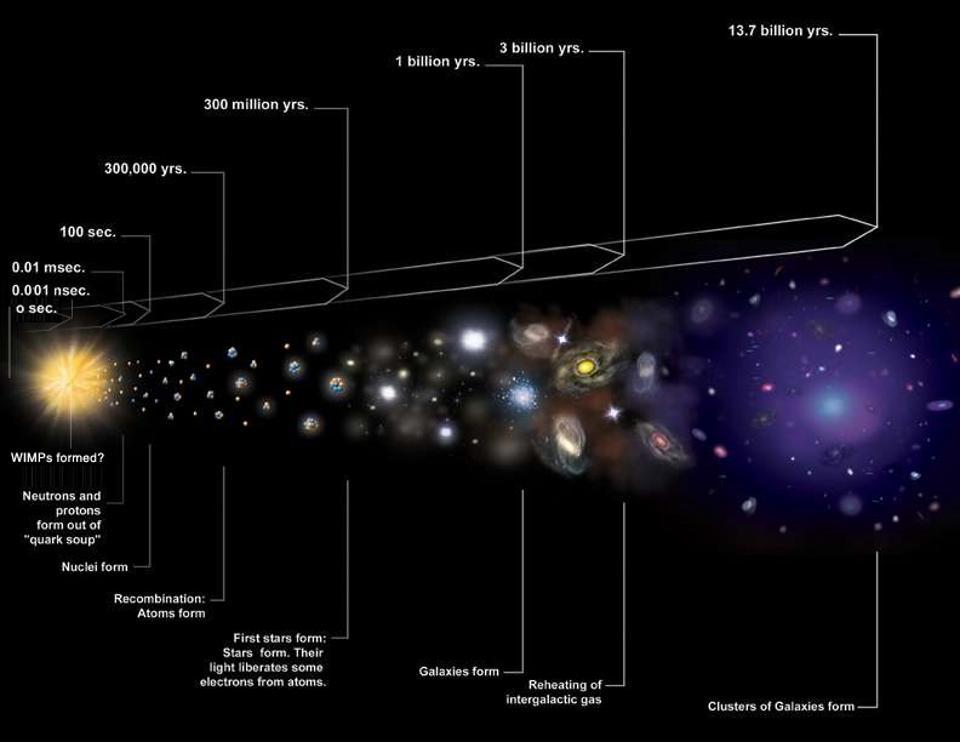
A visual history of the expanding Universe includes the hot, dense state known as the Big Bang and the growth and formation of structure subsequently. The full suite of data, including the observations of the light elements and the cosmic microwave background, leaves only the Big Bang as a valid explanation for all we see. As the Universe expands, it also cools, enabling ions, neutral atoms, and eventually molecules, gas clouds, stars, and finally galaxies to form.
Credit: NASA/CXC/M. Weiss
Let’s start by outlining the situation that motivated inflation, what the idea of inflation is, and what the theory does (and doesn’t) predict, both generically and in gory detail. Back in the 1960s and 1970s, we discovered the Cosmic Microwave Background, identified it as the hot Big Bang’s leftover glow, and began measuring its properties: its temperature, its blackbody spectrum, and its incredible uniformity. Alongside that, astrophysicists were attempting to measure both “what is it that makes up the Universe” as well as “how fast is it expanding,” a quest that we’ve made tremendous progress on, but that still continues today.
By the late 1970s, cosmologists Bob Dicke and Jim Peebles, as well as others, pointed out a series of puzzles that the Big Bang, if you extrapolate it arbitrarily far back, poses.
The Universe appears to have the same, uniform temperature in all directions, despite the fact that at no point in its past were these different regions in causal contact with one another: they had no way of thermalizing and coming to equilibrium. They call this the horizon problem.
The Universe appears to be very close to spatially flat: with the “stuff in the Universe” almost perfectly balancing “the expansion rate” out. This implies an extreme degree of flatness early on in cosmic history: of 1 part in 1024 if you go back to Big Bang nucleosynthesis and even more extreme if you go back earlier. They call this the flatness problem.
And third, if you go all the way back to an arbitrarily hot, dense state, you’d have enough energy to create anything admissible in physics, with many extensions to the Standard Model leading to high-energy relics like magnetic monopoles, even though we see none in our Universe. They call this the monopole problem.
How, then, could we solve these problems while still maintaining the successes of the hot Big Bang?
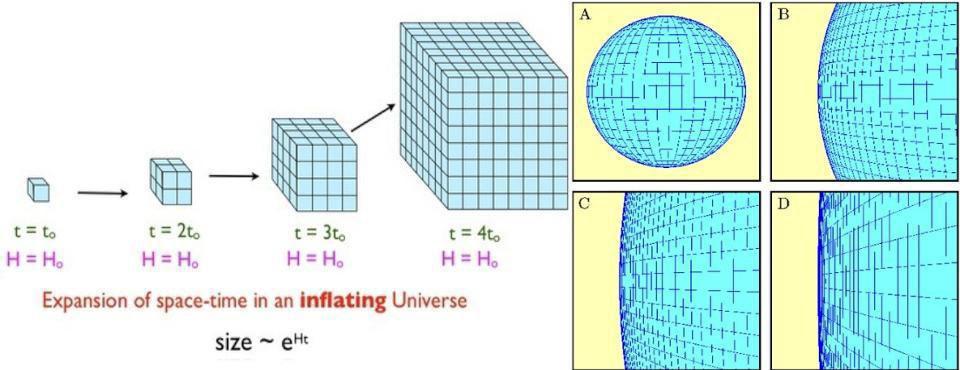
Exponential expansion, which takes place during inflation, is so powerful because it is relentless. With every ~10^-35 seconds (or so) that passes, the volume of any particular region of space doubles in each direction, causing any particles or radiation to dilute and causing any curvature to quickly become indistinguishable from flat. After only a few hundred doubling times, or ~10^-32 seconds, a fluctuation that was initially smaller than the Planck scale would now be stretched to be larger than the presently observable Universe.
Credit: E. Siegel (L); Ned Wright’s Cosmology Tutorial (R)
That’s where the idea of (and original motivation for) cosmic inflation came from. On the one hand, you can always say “these problems aren’t really problems; they’re just initial conditions” and assert that the Universe, at the start of the hot Big Bang, was born this way. It was born with the same temperature everywhere, it was born spatially flat, and it was born in such a way that those non-existent high-energy relics were forbidden. You can say that, but that’s also not a physically satisfying solution; that’s an appeal to initial conditions, rather than concocting a mechanism to solve these problem.
However, the idea of cosmic inflation actually does solve these problems. By hypothesizing that a phase of relentless, exponential expansion preceded and set up the hot Big Bang, inflation implies the following.
That the Universe should be the same temperature everywhere because “everywhere” that we observe arose from the same, initially inflating region that was stretched to encompass our entire observable Universe, endowing it with the same temperatures everywhere.
That the Universe should be spatially flat, or extremely close to it, because inflation took a section of the Universe and expanded it so severely and so relentlessly that the part of it we observe now appears so large that it’s indistinguishable from flat to our observations.
And that the Universe must not have reached those arbitrarily high temperatures or energies as part of the hot Big Bang, but that when inflation ended, it created only a hot, but not Planck-scale hot, thermal bath from which our modern Universe emerged, explaining why no ultra-high-energy relics, like magnetic monopoles, can be found in our Universe.
In other words, inflation was proposed, initially, to solve these major puzzles with the Big Bang, and did so successfully.
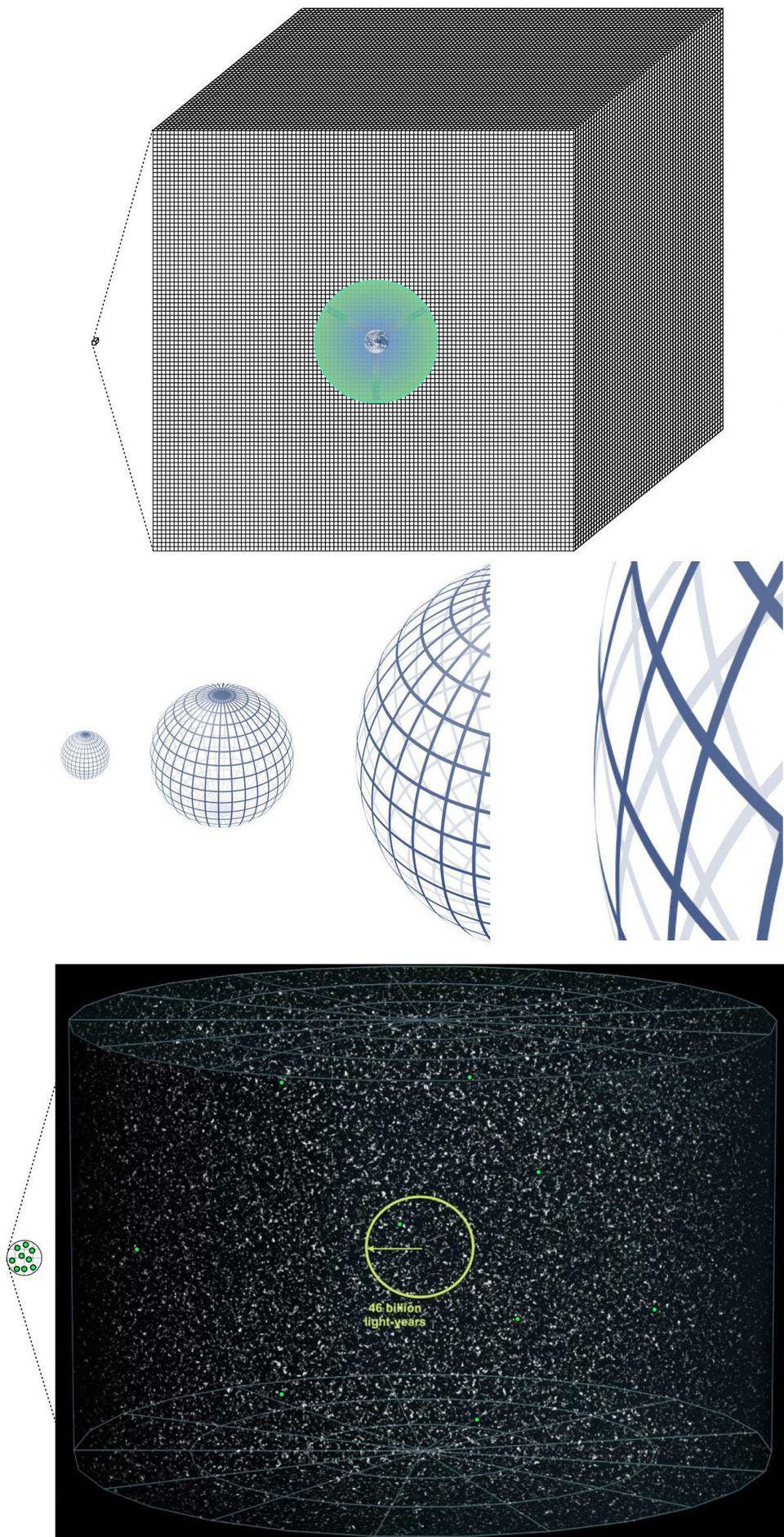
In the top panel, our modern Universe has the same properties (including temperature) everywhere because they originated from a region possessing the same properties. In the middle panel, the space that could have had any arbitrary curvature is inflated to the point where we cannot observe any curvature today, solving the flatness problem. And in the bottom panel, pre-existing high-energy relics are inflated away, providing a solution to the high-energy relic problem. This is how inflation solves the three great puzzles that the Big Bang cannot account for on its own.
Credit: E. Siegel/Beyond the Galaxy
The originally proposed version of inflation, however, failed in a major way: it didn’t yield an isotropic (same in all directions) and homogeneous (same in all locations) Universe. If an inflating patch of space were like a bubble being blown, then the original version of inflation would have placed all of the energy in the bubble walls when inflation ended. The key was not to use a first-order phase transition (similar to quantum tunneling) to end inflation, but a slow-roll, second-order phase transition. This would solve what was known as the “graceful exit” problem, with two possible general classes of solution: the “new inflation” solution with a plateau-like top and valleys beneath, and the “chaotic inflation” solution with large slopes up the sides of a potential with a central valley.
In either case, these two flavors of inflation also generically predicted:
a uniform Universe with the same temperature everywhere,
that quantum fluctuations, normally on very small scales, would be generated and stretched across the Universe,
leading to seeds for both density (scalar) fluctuations and gravitational wave (tensor) fluctuations, or departures from true uniformity,
where the density fluctuations lead to a series of peaks and valleys in the cosmic microwave background and a prominent acoustic oscillation feature in the modern large-scale structure,
and then where the specifics of the type of inflation that occur lead to specific values for the tilt of the density fluctuation spectrum (the scalar spectral index, ns), the magnitude of the gravitational wave spectrum (the r-ratio), and the departure from perfect flatness.
Over the subsequent years, we’ve confirmed all of these predictions to the limits of our measurement capabilities, finding a scalar spectral index, ns = 0.965, no departures from flatness down to the ~1% level, and constraining the magnitude of the gravitational wave spectrum to have r < 0.02 or so.
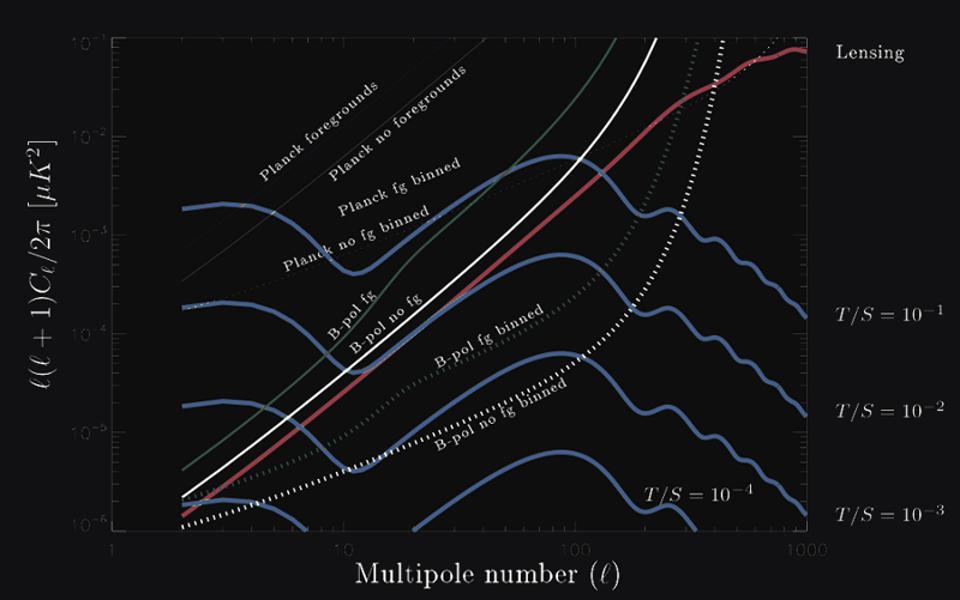
The contribution of gravitational waves left over from inflation to the B-mode polarization of the cosmic microwave background has a known shape, but its amplitude is dependent on the specific model of inflation, and can only be constrained observationally. These B-modes from gravitational waves from inflation have not yet been observed, but detecting them would help us tremendously in pinning down precisely what type of inflation occurred. A false detection, from the BICEP2 team, famously occurred in the early 2010s, but was swiftly refuted. We now know that the r-ratio, represented on the y-axis, must be no greater than about ~0.01.
Credit: Planck Science Team
This should be considered, universally, to be an overwhelming set of successes for cosmic inflation.
Back when inflation was first proposed in the early 1980s, we knew about dark matter, but not about dark energy; we thought the Universe was open and underdense, not flat. But the discovery of dark energy in 1998, plus subsequent CMB measurements that indicated a flat Universe, further validated inflation. The discovery of the peaks-and-valleys in the CMB, from BOOMERanG, WMAP, and Planck, validated inflation’s predictions, and the discovery of the baryon acoustic oscillation signature in SDSS and now DESI data again aligns with inflation.
The fluctuations were determined to be adiabatic and not isocurvature, further validating inflation.
The fluctuations have a slightly larger magnitude on large-scales than small-scales, again consistent with inflation.
The maximum temperature allowable for the hot Big Bang was determined to be over a factor of 1000 below the Planck scale: once again agreeing with inflation.
Super-horizon fluctuations were detected: some very strong evidence favoring inflation and disfavoring the hot Big Bang without inflation.
And the measurements of the scalar spectral index, plus the limits on primordial gravitational waves, favor certain models of inflation (like slow-roll, single-field models) while disfavoring others (like hybrid inflation and large-field models).
Despite all of these successes, however, inflation still has its detractors. The two most common arguments they often bring up are the measure problem and the assertion that “inflation could predict anything,” but these are not necessarily solid arguments against inflation.
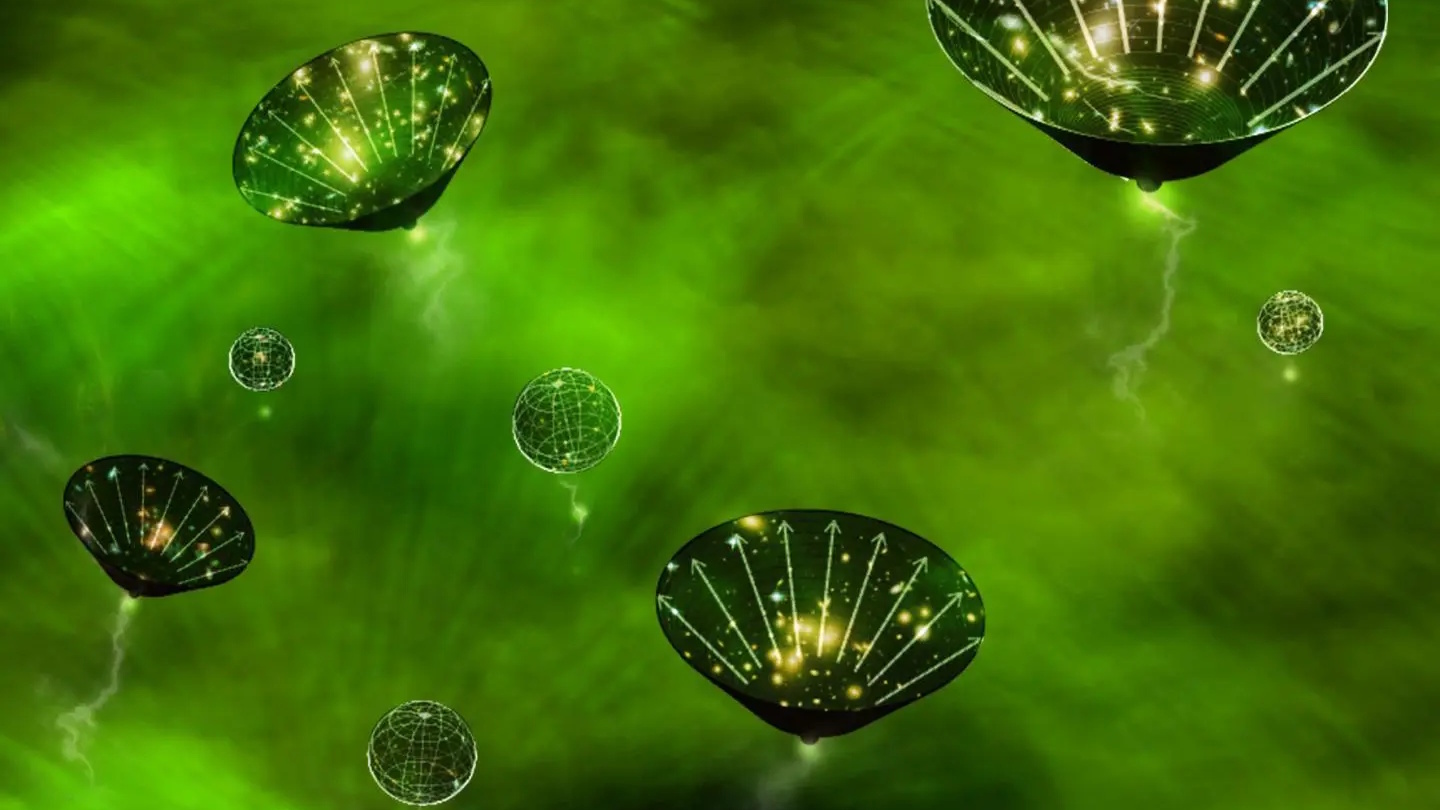
We normally conceive of our Universe as having emerged from a preceding period of cosmic inflation, with our Big Bang occurring where one region of inflating space ceased inflating and transitioned to being dominated by matter and radiation. However, in other locations, inflation continues indefinitely, giving rise to other baby (or bubble) universes, potentially with very different properties and conditions from our own.
Credit: Kavli IMPU
The “measure problem” is basically a statistical argument: we don’t know what the state that preceded cosmic inflation was like, so how can you assert that inflation will yield the Universe we observe when you don’t know how to quantify likelihoods at all?
And this is technically true. We don’t know how inflation started, or what pre-inflationary state it started from. All we can be sure of, based on our observations and the proofs we can concoct, is that:
According to critics, inflation doesn’t necessarily predict a flat Universe; you can take a Universe of whatever curvature you want and inflate it for whatever amount of time you choose, and “cook up” an initial flatness that would lead to any value for modern-day flatness that you want. Furthermore, we can’t know the initial, pre-inflationary state, so one could argue that the conditions necessary to trigger inflation might be so extremely rare that even if inflation did occur somewhere, it might not be able to become the “most likely” outcome for the Universe if the remaining, never-inflating Universe were large enough.
And while these arguments aren’t wrong in the absolute sense, they do ignore the strongest property of inflation: its ability to be an attractor solution.

This outline of a cloud represents phase space: where the different regions of the cloud represent the different possible outcomes that can occur, and the amount of the full cloud that they take up represents their relative probabilities.
Credit: public domain
What you see, above, is a picture of what physicists might call “phase space” in a general sense. The inside of the cloud-like figure represents a total of “100%” of all of the possible states that can-and-do exist all throughout the entirety of space-and-time: whatever they are. Phase space is useful under a wide variety of physical applications, representing any property of nature that we like.
When it comes to inflation, it might help to consider, from whatever pre-inflationary state that spawned it (and yes, our ignorance here is profound), what some possibilities are for what different regions of the greater Universe could be doing just before inflation gets its start.
Some portions of the Universe could be static, where they’re remaining the same in terms of size, over time.
Other portions might be expanding, in a similar or different fashion to how the space of our observable Universe is expanding today.
Still other portions could be contracting, like expansion-in-reverse, whether they’re collapsing under their own gravity or in a state of contraction for a completely different reason.
There could be oscillating regions: that alternately grow-and-shrink and then repeat that cycle, or that don’t stably do just one thing like the other regions.
And finally, there could be a region — arguably, perhaps there must have been at least one tiny region like this — where the right conditions are met for inflation to begin.
If that’s what’s going on, initially, then the initial “phase space” of the Universe at the start of inflation might look like the diagram pictured below.
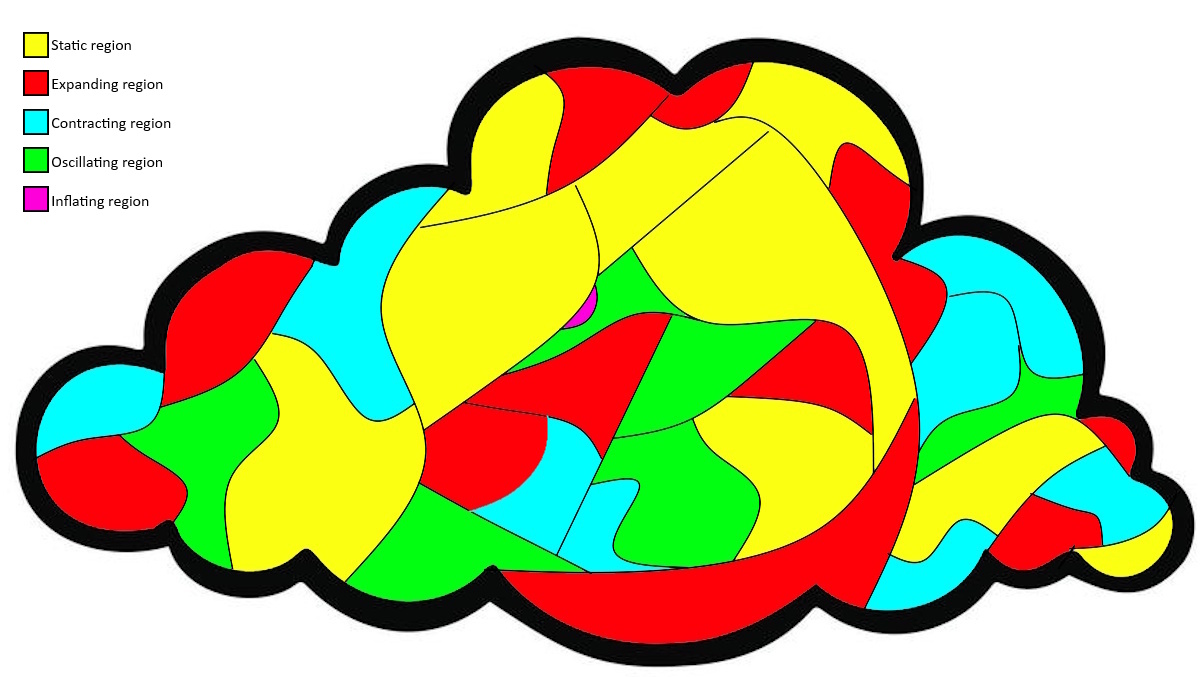
This phase space diagram shows one possible configuration for the types of regions that may have existed in the Universe back before inflation began: with expanding, contracting, static, and oscillating regions. However, if we include even one very small region that has the right conditions for inflation to commence, in purple, then that inflationary region will quickly expand in such a way that it will take over practically all of phase space.
Credit: E. Siegel
It shouldn’t be controversial to say, “okay, imagine all the things that are possible in some early state of the Universe, and assume that all possibilities are realized somewhere.” This isn’t necessarily true, of course, but it does allow us to consider what would happen for each such possibility, relative to all other possibilities, when it comes to the types and likelihoods of each class of outcomes occurring.
That’s because we still have the laws of physics to contend with, and it’s those laws of physics that allow us to start with:
how fast the Universe is expanding/contracting in whatever location we’re describing,
and what types of matter, radiation, curvature, and/or energy are present in those regions,
and then that allow us to solve for how that section of the Universe will evolve into the future.
For regions that are filled with matter, antimatter, radiation, or even exotic entities like monopoles or cosmic strings, we can calculate how those initially expanding, contracting, or static regions will evolve. For regions with the right sets of properties, we can imagine oscillating possibilities.
But at some point, if we’re sampling the space that contains all possible states fairly, we’ll encounter a region like the one shaded in purple, above: a region of cosmic inflation. When inflation begins, there are specific rules governing how that region is going to evolve: by expanding relentlessly and exponentially, doubling in size again and again with each brief moment that elapses.
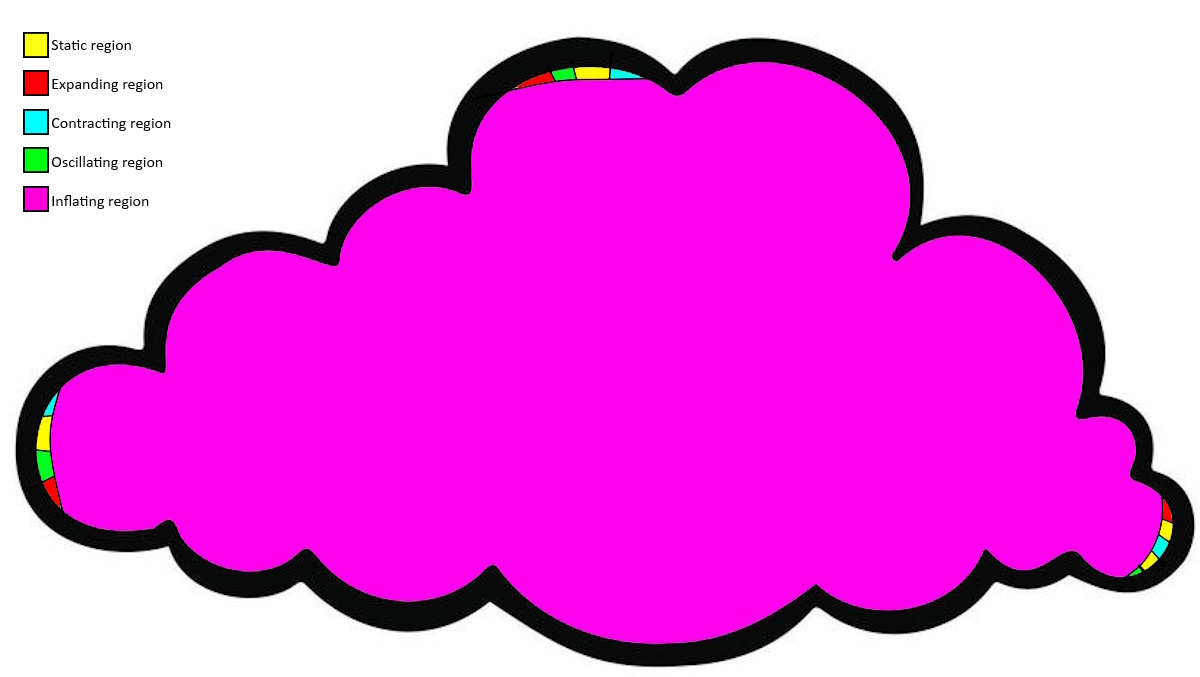
This phase space diagram represents the time-evolution of the earlier phase space diagram, where different regions expand, contract, remain static, oscillate, or inflate according to their initial conditions. Even if the initially inflating region was incredibly small, the fact that inflation serves as an attractor solution implies that, in very short order, all of phase space will be taken over by the inflating region.
Credit: E. Siegel
All other regions, whether they expand or contract or behave otherwise, will not expand as quickly or as relentlessly as the inflating ones. As a result, practically all of phase space, after just a fraction-of-a-second’s worth of inflation, will now represent a region where inflation occurred. This isn’t necessarily because the other regions are shrinking; they can be shrinking, but they can be growing as well. It’s because the way that inflation works — doubling in an instant, then doubling again in the next instant, and again and again and again and so on — causes the space where inflation is occurring to expand and increase in volume so much more quickly than with any other possibility that obeys the known laws of physics and doesn’t lead to a pathological (i.e., Universe-destroying) set of conditions.
That’s why we say that inflation is an attractor solution: the state towards which everything tends to evolve. Once you begin inflation anywhere, in a region of any size, it quickly takes over the entire Universe; anyplace you wind up is overwhelmingly likely to have had an inflationary past.
In fact, you can go on and prove that:
if you want there to have been enough inflation to solve the original puzzles posed and popularized by Dicke and Peebles about the Big Bang,
then that heavily restricts the types of inflation that could have occurred,
and of all of those types, 100% of them lead to a future-eternal inflating state,
where inflation comes to an end in any given region after a finite amount of time,
but those regions also spawn still-inflating regions that not only continue ad infinitum, but that regions where inflation ends can never collide or interact, leading to a series of disconnected “bubble” Universes.
We then live inside one of those bubble Universes where inflation ended, and the portion that we can see is smaller than the size of the bubble Universe we inhabit.
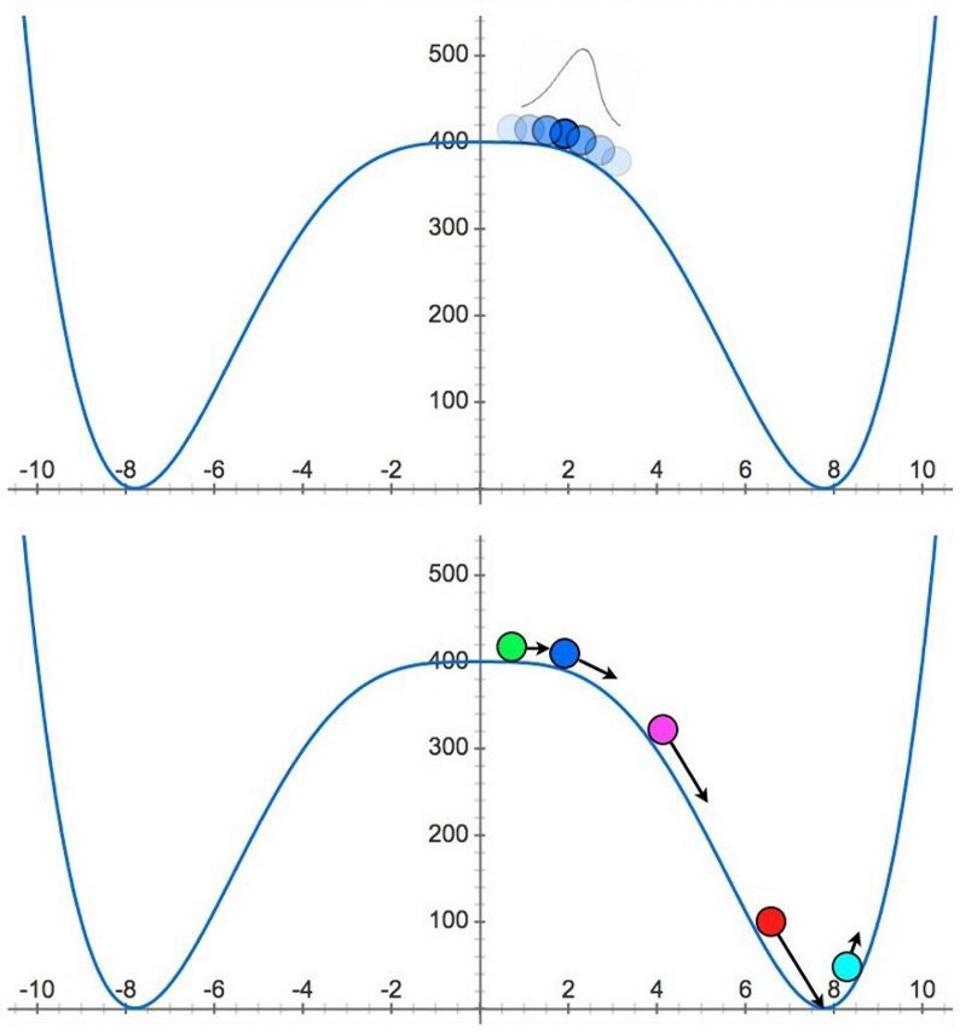
If inflation is a quantum field, then the field value spreads out over time, with different regions of space taking different realizations of the field value. In many regions, the field value will wind up in the bottom of the valley, ending inflation, but in many more, inflation will continue so long as the ball remains on the flat part of the hill, where it can remain arbitrarily far into the future. The regions where inflation continues on are sufficiently important that they lead to a situation known as “Eternal Inflation,” where once inflation commences, it forever continues, at least in some places, arbitrarily far into the future.
Credit: E. Siegel/Beyond the Galaxy
So sure: we can complain that it’s possible to cook up some specific, odd behavior by choosing a particular model of inflation. We can complain that we don’t have a full understanding of inflation and its dynamics, so we can’t solve the measure problem and know the probabilities of the full spectrum of outcomes. And we can complain that there are alternatives to inflation that we can concoct that mimic its successes while not being able to differentiate between these schemes that were concocted after-the-fact rather than before the observations were acquired, like inflation did.
But these complaints do not negate the actual successes of inflation, nor its ability to make truly generic predictions. The facts are:
we do have a nearly-perfectly (but not quite perfectly) scale-invariant spectrum of density fluctuations, with slightly more power on large-scales than on small-scales,
they are adiabatic in nature and do exist on super-horizon scales,
the Universe did have a maximum temperature achieved in the hot Big Bang that’s well below the Planck scale,
that we see no evidence for features that were ever trans-Planckian (i.e., below about 10-35 m in size) ever showing up or getting stretched to macroscopic scales in our modern Universe,
and the Universe is consistent with spatial flatness, with predicted departures (from inflation) that have yet to be observed at between the 0.0001% and 0.01% level,
and that inflation predicts a specific spectrum of gravitational waves, with an unknown (but possibly very small) amplitude, that has yet to be discovered.
It’s important to consider and work on these puzzles, as well as to acknowledge them. Simultaneously, however, the existence of currently unsolved puzzles does nothing to undermine the facts of what we already know, or the successes of predictions that were teased out long before the measurements came through and allowed us to weigh in on them. Inflation has succeeded where all other alternative explanation have not, and even though there are still some vociferous detractors of it, it has — along with dark matter, dark energy, and massive neutrinos — become an indispensable part of our modern “consensus” picture of our Universe.
The author acknowledges Niayesh Afshordi’s and Phil Halper’s book, Battle of the Big Bang: The New Tales of Our Cosmic Origins, for its excellent discussion of the Measure Problem.
Sign up for the Starts With a Bang newsletter
Travel the universe with Dr. Ethan Siegel as he answers the biggest questions of all.

